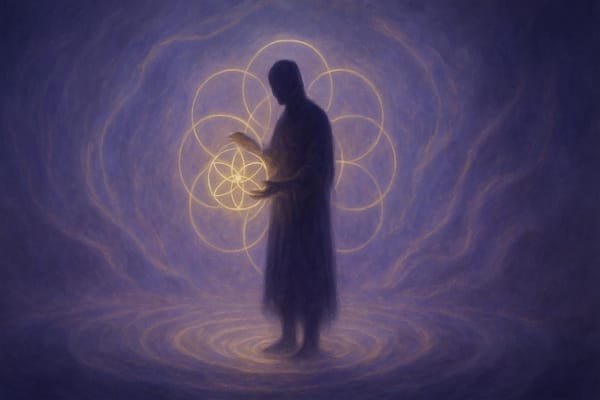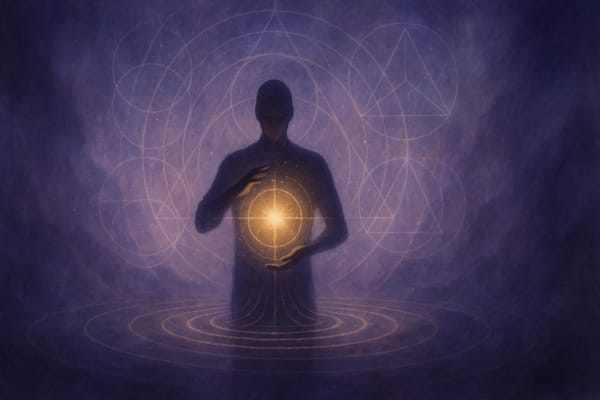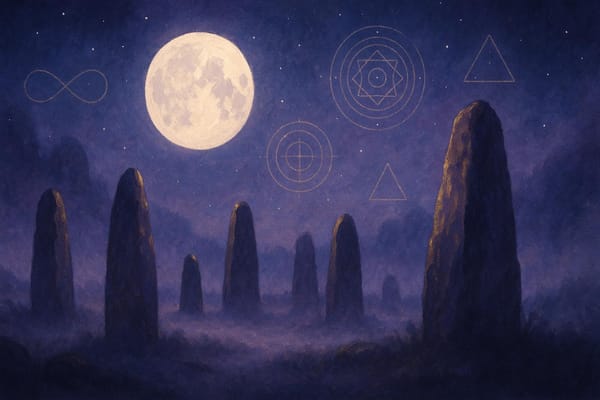Ultimate Guide to Earth Gridwork
Explore Earth gridwork, a practice connecting to the planet's energy system through ley lines, vortex points, and sacred sites.
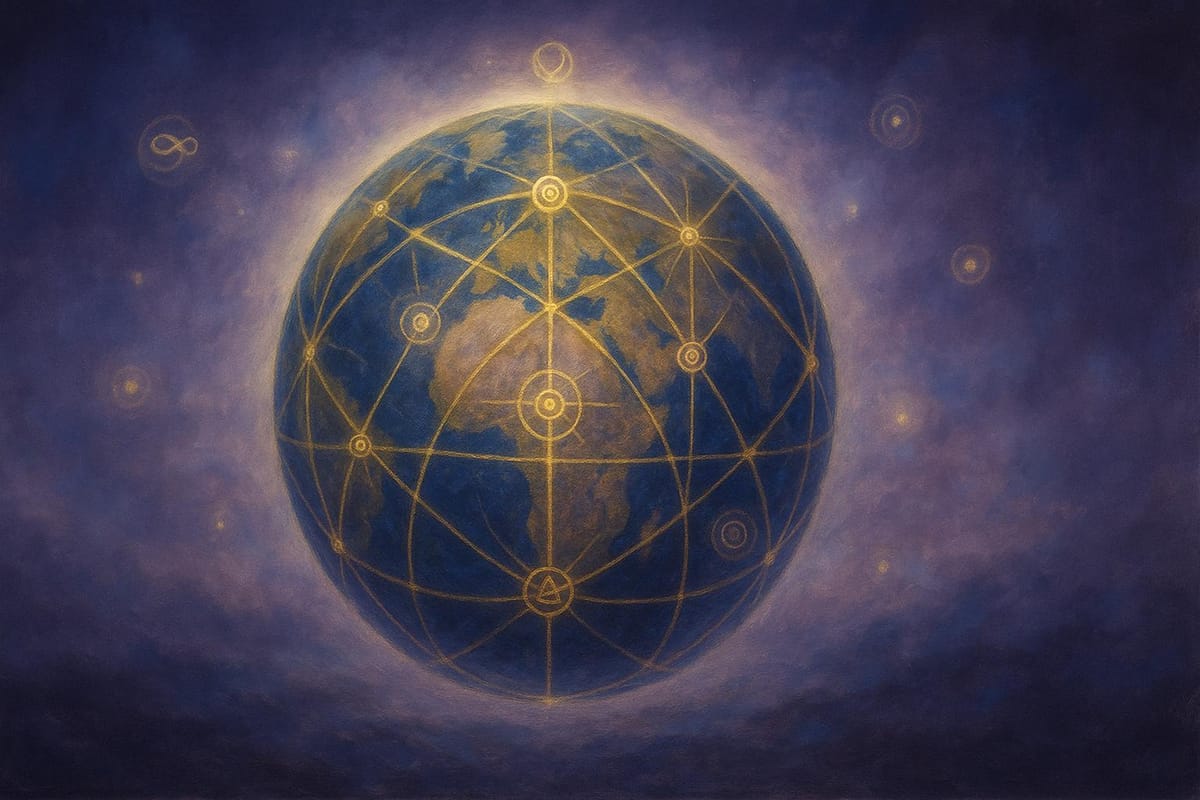
Earth gridwork is a practice that connects you with the planet’s energy system, focusing on ley lines, vortex points, and sacred sites. By aligning with these energetic pathways, you can help balance Earth's energy flow while deepening your own sense of connection and transformation. Practitioners use tools like meditation, dowsing, and intuitive sensing to map and stabilize energy grids, addressing disruptions caused by urban development, natural events, or emotional imprints. This work bridges ancient wisdom with modern perspectives, offering a way to engage with the unseen layers of reality.
Key Takeaways:
- Earth’s Energy Grid: Includes ley lines, dragon lines, power spots, and vortex points.
- Mapping Techniques: Use dowsing rods, meditation, or even EMF detectors.
- Disruptions: Caused by construction, technology, or emotional imprints.
- Restoration: Involves intention, rituals, and observation to harmonize energy flow.
- Simulation Theory: Frames gridwork as interacting with reality’s “code,” offering a deeper way to understand our role in shaping existence.
Whether you're drawn to sacred sites like Stonehenge or simply curious about the energy of your local landscape, gridwork invites you to step into a role of intentional care for the planet’s energy web - and your own transformation.
Earth Grids and Ley Lines | The Invisible Super-Science of the Megalith Builders | Megalithomania

How to Map Earth's Energy Networks
Mapping Earth's energy networks combines age-old traditions with modern tools to trace subtle shifts in energy. Rooted more in cultural and spiritual practices than in mainstream science, these methods offer a fascinating lens through which to view the natural world. Below, we delve into the key components and approaches used to map these grids.
Earth's Energy Grid Components
The energy grid of the Earth is often described through several interconnected elements:
- Ley lines: These are believed to link ancient sites, natural landmarks, and monuments in straight, purposeful alignments.
- Dragon lines: Unlike ley lines, dragon lines follow the natural curves of the land, tracing valleys, ridgelines, and other geographical features.
- Energy nodes (power spots): These are points where multiple energy lines intersect, creating areas of heightened energy.
- Vortex points: These locations are thought to concentrate or spiral energy, often associated with transformation or balance.
Techniques for Mapping Energy Grids
Those who engage in gridwork use a variety of methods to explore and chart these networks:
- Dowsing: This age-old technique involves tools like L-rods or pendulums to sense energy flows, relying on the practitioner's sensitivity.
- Intuitive sensing: Through meditation or body awareness, individuals attempt to perceive subtle shifts in energy. While subjective, this method emphasizes personal connection.
- Technology-assisted mapping: Tools like EMF detectors, magnetometers, and GPS-enabled apps can detect and map physical variations in energy, offering a more measurable approach.
These techniques help identify energy-rich locations, often sparking deeper exploration and connection.
Sacred Sites as Energy Grid Nodes
Certain locations around the world are frequently cited as nodes within Earth's energy grid, revered for their unique energetic qualities:
- Stonehenge: This iconic site is often described as a meeting point of energy lines, adding to its mystique and historical significance.
- Native American sites: Places like Bear Butte in South Dakota and Mount Shasta in California hold deep spiritual importance and are seen as energetic hubs.
- Ancient monuments: The Great Pyramid of Giza has long inspired speculation about its alignment with energy grid theories, reflecting a broader curiosity about the interplay between architecture and landscape.
- Sacred natural landmarks: Sites such as Mount Kailash in Tibet and Uluru in Australia are celebrated in various traditions for their profound energetic resonance.
These interpretations weave together historical, cultural, and personal experiences, forming the basis for gridwork practices that aim to connect individuals with the Earth's energetic landscape.
How to Find and Fix Energy Grid Disruptions
Energy grid disruptions are subtle shifts that can ripple through both natural surroundings and human experiences. Practitioners rely on keen observation and specialized techniques to identify these imbalances and work toward restoring harmony. Often, these disturbances manifest through environmental changes or personal sensations, offering clues to their presence.
What Causes Grid Disruptions
Gridwork theory suggests several factors can disrupt energy flow:
- Environmental changes: Activities like deforestation, mining, or urban development can interfere with natural energy pathways. Construction projects that cross traditional energy lines or sacred sites often result in blockages.
- Technological interference: Modern infrastructure, such as power lines, cell towers, and electromagnetic installations, can distort or mask the natural flow of energy.
- Emotional and social influences: Collective emotional stress or trauma, especially in areas with a history of conflict, can leave energetic imprints that require attention.
- Geological events: Natural phenomena like earthquakes, volcanic eruptions, or extreme weather events can shift or disrupt local energy patterns.
Warning Signs of Grid Imbalance
Practitioners rely on both environmental and personal observations to detect imbalances in the energy grid. Key indicators include:
- Environmental changes: Animals behaving unusually - such as birds avoiding certain areas - or plant life struggling to grow or thrive.
- Weather anomalies: Persistent fog, atypical wind patterns, or other unusual weather conditions that seem out of place.
- Personal experiences: People in disrupted areas may report feeling unusually tired, experiencing mood swings, or dealing with unexplained headaches.
- Community dynamics: Heightened social tension or unrest within a community may reflect underlying energetic disturbances.
These signs serve as starting points for deeper exploration and diagnostics.
How to Diagnose Energy Grid Problems
Diagnosing grid disruptions involves refining observations and using a mix of tools and techniques to pinpoint the issues. Practitioners often rely on:
- Field observation: Spending extended time in suspected areas, under varying conditions, to note shifts in energy, mood, or the environment.
- Targeted dowsing: Using tools like L-rods or pendulums to trace disrupted energy lines and locate specific points of interruption. Repeated sessions help confirm findings.
- Meditative assessment: Entering a meditative state to visualize the energy grid as a network of light. Disruptions may appear as dark spots or tangled areas, offering insight into their nature and origin.
- Technology-assisted methods: EMF detectors can identify anomalies that align with other observations, while GPS mapping and documentation reveal patterns over time.
- Community feedback: Insights from local residents add valuable context, helping practitioners understand the area's energetic state. Detailed logs and repeated observations help verify imbalances before taking corrective action.
These diagnostic steps lay the groundwork for restoring balance to the energy grid, ensuring that stabilization efforts are both precise and effective.
Rituals and Methods for Grid Stabilization
Working with Intention in Gridwork
Intention serves as the guiding force behind gridwork, acting as a deliberate expression of desire powered by belief and concentrated energy. By channeling this focused intent, energy grids can be stabilized effectively during rituals, creating a foundation for all other grid stabilization techniques.
Earth Gridwork and Reality as Simulation
Gridwork Through the Lens of Simulation Theory
When viewed through the lens of simulation theory, Earth's energy grid begins to resemble a complex coded system. These energetic networks, rather than being purely natural phenomena, act as interconnected pathways that shape our experience of reality.
Engaging with gridwork under this perspective becomes an intentional interaction with the system’s underlying structure. Each ritual or focused intention operates like a deliberate engagement with the system’s programming. In this way, gridworkers may find themselves co-creating reality, aligning their actions with the energetic "rules" of the system.
Grid disruptions, in this context, could be seen as glitches - anomalies in the energetic network. Stabilization efforts, then, act as a form of debugging, smoothing out these disruptions. Some practitioners even report immediate feedback, such as sudden weather changes, synchronicities, or noticeable energy shifts. These occurrences are often interpreted as reflections of their interventions, suggesting a dynamic relationship between the grid and those who work with it.
The process of gridwork also demands a level of precision similar to the logic required in programming. Just as coding relies on accuracy for predictable outcomes, gridwork calls for focused intent and clarity. This perspective not only deepens the understanding of gridwork but also connects personal transformation to a broader concept of cosmic engineering.
Sacred Illusion's Approach to Gridwork
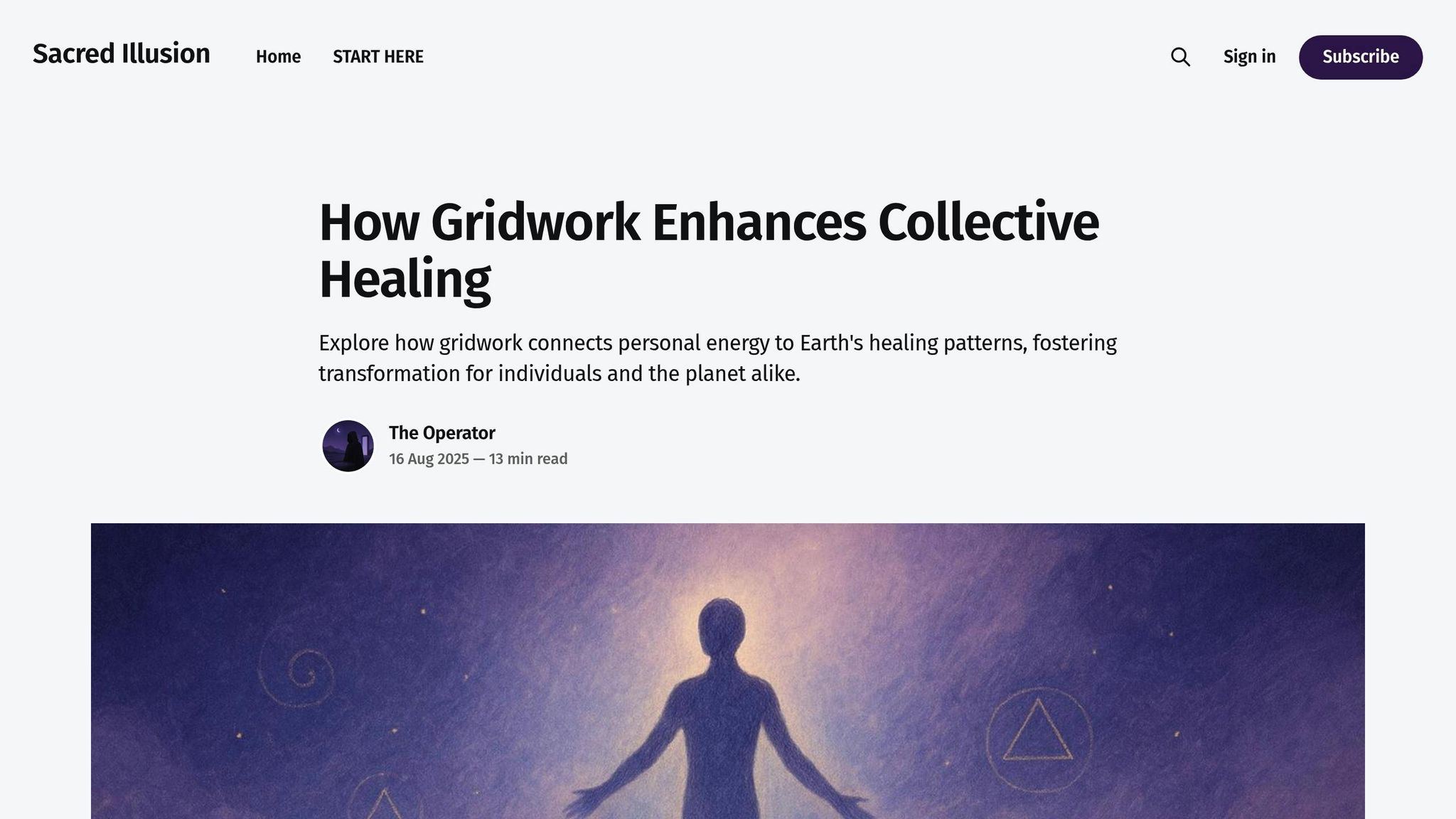
Drawing on simulation theory, Sacred Illusion approaches gridwork as a meeting point between mysticism and practical exploration. This perspective doesn’t demand rigid belief in a single metaphysical explanation but instead invites practitioners to observe, document, and remain open to different interpretations of reality. Whether viewed as code, dream, or something entirely unknown, interacting with Earth's energy networks offers tangible effects.
This approach emphasizes three key elements: presence, precision, and power. Presence ensures full engagement with the moment, allowing practitioners to connect deeply with the energetic flow. Precision provides the clarity needed for targeted and effective interventions. Power, in this context, is the focused intention and will that drives meaningful change. Together, these principles form the foundation of Sacred Illusion’s methodology for working with the grid.
For those exploring gridwork through this lens, the practice becomes more than traditional healing - it’s an invitation to actively participate in the unfolding of reality itself. Each session becomes an opportunity to blur the line between observer and participant, turning practitioners into explorers of the very fabric of existence. The grid, then, becomes not just a tool for transformation but a map for understanding the deeper layers of reality.
Becoming an Earth Gridworker
Stepping into the role of an Earth gridworker is both a practical commitment and a spiritual journey. It calls for a keen sensitivity to the unseen energetic patterns that weave through our world, paired with a grounded, methodical approach to ensure meaningful and effective action. As you take on this path, you become an active caretaker within Earth's energetic framework.
Begin by cultivating your awareness of energy flows in natural spaces - sacred sites, parks, or even your local landscapes. Spend time observing these places under different conditions, such as varying weather or times of day, to attune yourself to their subtle rhythms. As your perception sharpens, the next step is mapping. This involves carefully documenting energy networks, much like a scientist would track data. Keep detailed records of your observations, noting patterns and the outcomes of any interventions you make. This systematic approach helps separate genuine energetic phenomena from projections of imagination.
Learning to identify disruptions and key grid components is essential before attempting advanced techniques. Experienced gridworkers often stress that patience and preparation are the foundation of successful work. Rushing into interventions without a full understanding can cause more harm than good.
When engaging with the grid, clarity of intention is your most powerful tool. Approach your work with focus, presence, and precision, aligning with Sacred Illusion's principles to create noticeable stabilization effects. Both individual and group efforts have their place in this practice. Solo work fosters a personal and intimate connection with the grid, while group collaborations can amplify the energy and bring diverse perspectives. Many practitioners find that alternating between these approaches offers a fuller view of the energetic dynamics at play.
As your skills grow, your role expands beyond personal exploration to that of an energetic steward. You may find yourself addressing disruptions that impact entire regions. This requires ongoing learning - not just about energy work but also about the environmental, geological, and human influences on grid stability. By integrating these factors, you deepen your understanding and enhance your effectiveness.
Viewing gridwork through the lens of simulation theory offers an intriguing perspective. It frames your role as akin to debugging a cosmic system, aligning ancient healing traditions with a modern understanding of reality. Whether seen as repairing the Earth's energetic fabric or contributing to a vast consciousness network, the results of your work remain tangible and impactful.
Adaptability is key. Each location presents unique challenges, and your techniques will evolve as you encounter new scenarios. The field itself is constantly growing as practitioners share insights and refine traditional methods with contemporary knowledge.
Ultimately, becoming an Earth gridworker is an exploration of the interplay between personal awareness and planetary systems. It invites you to test the boundaries between being an observer and an active participant, revealing deeper truths about your connection to the larger patterns of existence. Through this practice, you cultivate not just energetic sensitivity but a profound sense of belonging within the intricate web of life.
FAQs
How do I start practicing Earth gridwork in my area, and what do I need to begin?
To begin engaging with Earth gridwork, start by exploring how it links your own energy to the Earth's natural energetic patterns. This connection can bring harmony and restoration, not just to yourself, but to the environment around you. The practice involves identifying energy-rich locations, noticing areas where the flow feels disrupted, and learning ways to help stabilize these energetic currents.
Getting started doesn’t require much - just curiosity and a willingness to connect with the world around you. Many find it helpful to use tools like maps to locate energy points, a journal to record observations, and a quiet space for meditation or focused energy work. As you deepen your understanding, you can experiment with more advanced methods that align with your intentions and the unique energy of your surroundings.
What are some common signs that the Earth's energy grid might be disrupted in my environment?
Disruptions in the Earth's energy grid can show up in various ways. You might encounter unexpected electrical problems, like frequent power surges, outages, or odd fluctuations in voltage. These issues often align with external factors, such as severe weather events or physical damage to the infrastructure.
On a less obvious level, electromagnetic irregularities might arise. These could include strange electrical activity, brief disturbances, or unusual oscillations. Such anomalies might cause electronic devices to malfunction or lead to other unexplained occurrences around you. If you notice an unusual instability in your environment, it might be worth taking a closer look to determine if grid disruptions are at play.
How does simulation theory influence the way practitioners approach Earth gridwork?
When seen through the lens of simulation theory, the Earth's gridwork takes on a new dimension - no longer just physical or energetic, but part of a vast, virtual system. This perspective places consciousness and intention at the forefront, treating them as tools to influence or even 'recode' the grid. It invites practitioners to approach their work with a sense of purpose, focusing on mindful creation and deliberate action.
This understanding also deepens the feeling of interconnectedness, revealing the grid as a vital thread within the fabric of a simulated reality. By viewing it as a dynamic system shaped by awareness, practitioners can fine-tune their methods to align with larger aims of healing, harmony, and spiritual growth.


